Secretaries of L&I
1913-1919
John Price Jackson

John Price Jackson was born September 27, 1868, in Philadelphia. His early education was obtained in the private and public schools of Kennett Square. While Jackson was a young man he learned the trade of electrical wireman. He graduated first in the course of Mechanical Arts, and second in the course of Mechanical Engineering at the Penn State College, receiving a Bachelor of Science and later the degrees of Mechanical and Electrical Engineer. He also received the degree of Doctor of Science from the University of Pittsburgh for eminence in engineering science and educational work.
After leaving college, Jackson was for some years a practicing engineer, largely engaged in building electric light and railway plants. Later he was professor of Electrical Engineering at Penn State College, where, in 1906, he became Dean of the School of Engineering. While at Penn State College he had many outside interests as a consulting engineer for various corporations and municipalities, and in scientific investigation. As a consulting engineer he was responsible for the first large city system of luminous arc lamps used in this country. In purely business affairs he was interested in public utilities and banking.
He was a Fellow of the American Institute of Electrical Engineers and a member of the American Society of Mechanical Engineers, a past director and vice president of the American Society for the Promotion of Engineering Education; President of the Engineers Society of PA; Past President of the National Land Grant College Engineering Associations; and a member or honorary member of several other state or national technical societies and social clubs. He also was a member of the State Engineers’ Commission.
He co-authored, with Dugald C. Jackson, Professor of Electrical Engineering at MIT, Alternating Currents and Alternating Current Machinery, published in 1894 by MacMillan and Co. The book was widely used as a text and reference. He also co-authored two more books with the same publisher: Elementary Electricity and Magnetism in1903; and "Alternating Currents" in 1913. In addition, he contributed largely to technical society transactions and other technical publications.
While at the Penn State College he was for several years school director of the local district. At the request of the Pennsylvania Railroad Company, he supervised and directed the establishment, in the name of the Penn State School of Engineering, of a continuation school for apprentices at Altoona and other points. He also, under the same auspices and in cooperation with the School Board at Williamsport, ran a model vocation school for the industrial employees of that city. In 1910, under the School of Engineering at Penn State, he organized, in cooperation with the Pennsylvania Railroad Company, the PA State Highway Department, and the U.S. Office of Roads, a campaign for good roads throughout PA. A movable exhibit and lecture room installed upon railroad cars were used for the campaign.
He was appointed Commissioner of Labor and Industry on June 2, 1913, by Governor John Kinley Tener, and re-appointed on June 2, 1917, by Governor Martin Grove Brumbaugh. On June 19, 1917, following the declaration of war with Germany, Commissioner Jackson was appointed by the President to the rank of Major in the Engineering Section of the Officers Reserve Corps of the U.S. Army. He entered active military service overseas in November 1917, on leave of absence from state office.
From Smull's Legislative Handbook, 1917.